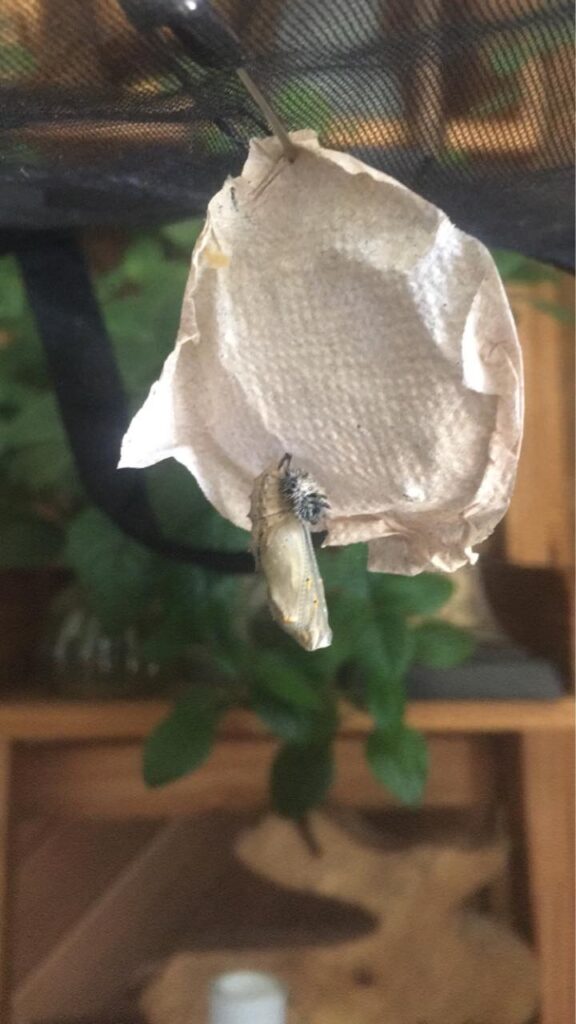Jeannine Steinke, a volunteer with Whitecourt Communities in Bloom, has reared butterflies for several years with her children and those in her dayhome. The experience of seeing butterflies transition through their cycle is rewarding not only for the children but for her too. “I had heard of them doing it in the schools, so I approached one of the teachers, and from there, I ordered my own,” explained Steinke. “It really is amazing to watch.”
A couple of years ago, the Town said they liked the idea and wanted to use the butterflies in conjunction with their Pollinators Workshop through Communities in Bloom. “It was perfect because it goes hand in hand. They are pollinators, and rearing them shares that education with people.” Steinke shared her passion for winged insects with children and adults through many different events, including the Children’s Festival. “The experience of getting to see how it all happens is wonderful. Seeing how the kids learn and even adults and seniors get interested too. I love seeing people learn from these types of things and learn to respect these pollinators because they are especially important. They are important for our ecosystem and for our ability to have food on the table.”
With the pandemic, Communities in Bloom still wanted to bring the experience to residents but needed a new way to do it since they could not hold their regular workshops or attend events. “We decided to blog it and videotape it so that we could put them on Facebook since no one was able to attend any of the workshops and events. That was how we decided to bring it forward to the public,” explained Steinke.
Last year, on July 6, she was able to release 18 butterflies. This year, the company was unable to provide as many. “I was able to get ten, but two didn’t survive the trip, and now we are down to six. It is all part of the rearing process. You are going to have some that don’t make it. Sometimes you have 100 percent success, and other times you have some that do not make it. You never know why. I have talked to the place where I get them from, and they said it could be a multitude of different things.”
In her June 1 video, Steinke shared the changes that one of her caterpillars was undertaking. “When I was cleaning his little cup out, I noticed that there was a bunch of little red ones, which is a sign that he is about to enter chrysalis form.” The little red ones that she refers to are frass balls or waste balls. When they turn red, it signals that the caterpillar is finished eating and will soon attach itself to transform. A bit further in the video, Steinke shows the little critter hanging inside the net home, where it will stay until it becomes a butterfly.
Having been with Communities in Bloom for five years, Steinke said that she loves being part of the group. “I had actually won a couple of Communities in Bloom competitions, and then I asked if they needed volunteers, and they did, so I joined. I just love all the aspects of what they represent.”
Once the butterflies release from their chrysalis, Steinke said she would release them into the wild soon after. “I have to release them within a couple of days. It would be cruel to keep them caged up once they can fly.” She will continue sharing her videos on the Whitecourt Communities in Bloom Facebook page. “When they come out of their chrysalis, they actually don’t have any colour in their wings. Once out, they pump their wings with this red liquid, and you can see their wings go from a dull grey-brown to a vibrant red and black. It is pretty cool to watch.” She has a video up from last year that shows the significant change and hopes to have another video showing it this year if time allows.
One neat fact that Steinke said surprised her to learn was that butterflies do not travel the way people think they do. “People have this idea in their heads that a single butterfly that we release is going to go all the way down to Mexico, and that actually isn’t true. They go through multiple laying egg and caterpillar stages before they get there and likewise back. There is something preprogrammed into butterflies that they just know where to go even when they are born mid-journey,” she explained.
“The daylight does help a lot with that. I cannot keep these butterflies in the dark because they would ultimately die. They need daylight to help with their circadian rhythm, which helps them find the direction for migration. It is so cool! I had no idea that there were that many life cycles in that journey. I remember being surprised when we learned that. So, that butterfly you see might not have been that far away, but its grandparent or great-grandparent was.” To view the videos and keep up-to-date with the caterpillars as they become butterflies, visit the Whitecourt Communities in Bloom Facebook page.








More Stories
Community spirit shines at large-scale youth baseball event
Birthday party chaos sung beautifully by Pumpjack Players’ youth in spring musical
Gearing up for another season of cars, cruising and camaraderie